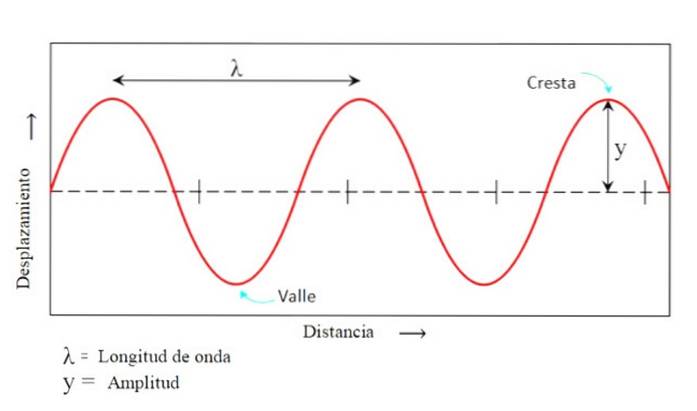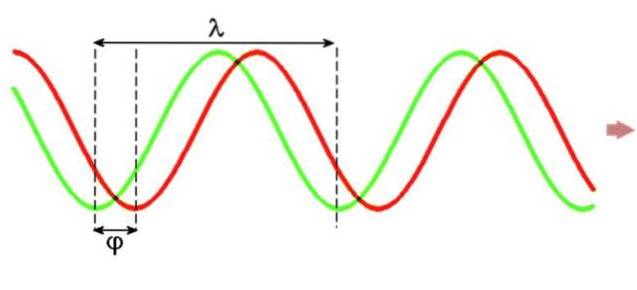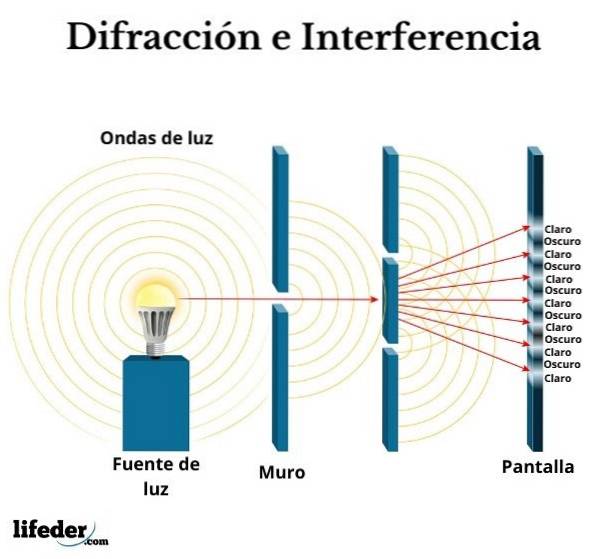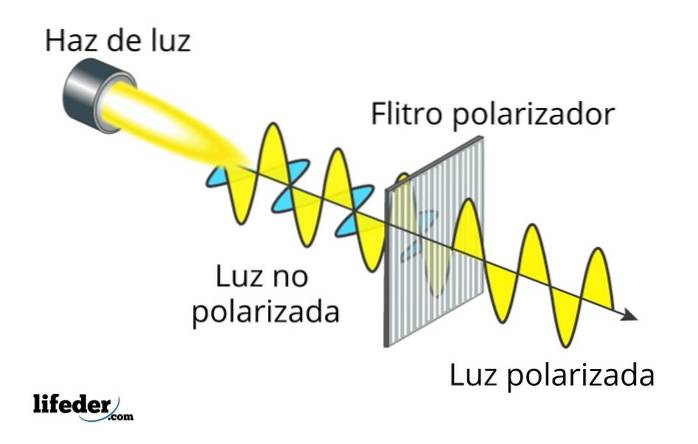
Wave optics

What is wave optics?
The wave optics, also called physical optics, studies the behavior of light in its manifestation as a wave. Light is an electromagnetic wave, and it had already been predicted by James Clerk Maxwell (1831-1879) in his equations.
Therefore, light experiences the same phenomena as any other type of wave. At the microscopic level, light is produced by atoms and molecules in matter undergoing internal electron restructuring. And through these processes light is emitted, consisting of an electric field and a magnetic field, both dependent on time, which generate each other..

Such fields, coupled perpendicularly, move like a wave capable of propagating transversely in a vacuum. That is, the wave oscillates perpendicular to the direction of propagation and the speed of the wave is a constant and in a vacuum it is 300,000 km / s.
However, when light interacts with matter, then it behaves like a particle. This particle is called photon and is manifested in phenomena such as black body radiation and the photoelectric effect, among others.
That is why optics is divided into three areas:
- Wave optics, focused on the wave phenomena of light.
- Quantum optics, that studies light when it behaves as a particle when interacting with matter.
- Geometric optics, oriented to the description of the geometric aspects of the light path: reflection and refraction.
What does wave optics study?

Wave optics is the area of optics that focuses on wave phenomena of light:
- Interference
- Diffraction
- Polarization
- Reflection
- Refraction
Although reflection and refraction are also manifestations of light, they are dealt with by geometric optics, as explained above. For this he makes use of the ray model, in which light is described as a straight line advancing perpendicular to the wave front. These rays are independent of each other and completely reversible..
But in this model it is not contemplated that light undergoes diffraction, although it is proven that it can, therefore geometric optics lacks sufficient scope to explain many aspects of the behavior of light..
Since these phenomena occur only in waves, it means that light has all the characteristics of a wave, both spatial and temporal. The first scientist to suggest this was Christiaan Huygens (1629-1695), and for this reason he had a bitter dispute with Isaac Newton (1642-1727), who always defended the corpuscular nature of light..
General characteristics of a wave

A wave is a repetitive disturbance that in principle can be modeled as a sinusoidal curve, either a transverse or longitudinal wave. Its spatial characteristics, that is, they refer to the shape of the wave, are:
-Ridges and valleys: are respectively the highest and lowest positions.
-Nodes: are the intersections of the wave with the reference line corresponding to the equilibrium position.
-Wavelength: It is almost always denoted by the Greek letter λ (lambda), and is measured as the distance between two successive ridges or valleys. Or also between a point and the next point that is at the same height and belongs to the next or previous cycle. Each color in the visible light spectrum has a characteristic wavelength associated with it..
-Elongation: is the vertical distance measured between a point belonging to the wave and the reference line.
-Amplitude: corresponds to the maximum elongation.
Regarding the temporal characteristics, as has already been said, the disturbance moves in time periodically, therefore, a light wave has:
-Period, duration time of a phase.
-Frequency: number of waves that are produced per unit of time. Period and frequency are inverse of each other.
-Velocity: is the quotient between the wavelength λ and the period T:
v = λ / T

Wave properties
Interference
Electromagnetic fields can combine at one point, following the principle of superposition. This means that if two light waves of equal amplitude, frequency and phase difference φ, overlap at a point in space, their respective electromagnetic fields add up as vectors.
Interference occurs because the wave that results from the superposition may have a greater amplitude than the interfering waves, or on the contrary, a much smaller one. In the first case it is said that it occurs constructive interference, and in the second it is about destructive interference.
The first to demonstrate the interference of light waves from two sources was the English scientist and polyglot Thomas Young (1773-1829) in 1801 in his famous double slit experiment..
Diffraction

Diffraction consists of the deviation from the rectilinear behavior that a wave undergoes when it encounters an obstacle or an opening in its path, as long as the dimensions of these are similar to the wavelength.
Sound wave diffraction is very easy to experience, but since the wavelength of visible light is very small, on the order of a few hundred nanometers, it is a bit more complex to determine..
Polarization

Light consists of two fields perpendicular to each other, one electric and one magnetic, both perpendicular to the direction of propagation. Non-polarized light consists of a disordered superposition of waves whose electric field has random directions, on the other hand, in polarized light, the electric field has a preferential direction.
Applications
Interferometry
Optical interferometers are devices used to measure distances with high precision. In addition, they can also measure wavelengths, refractive indices, the diameter of nearby stars and detect the presence of exoplanets..
The Michaelson-Morley experiment was carried out with an interferometer. In this experiment it was found that the speed of light is constant in vacuum.
Polarimetry

Polarimetry is a technique used in the chemical analysis of substances through the rotation of a beam of polarized light that passes through a substance optically. Its use is frequent in the food industry to determine the concentration of sugar in beverages such as juices and wines..
Communications
In communications, light is used for its ability to transport information, for example through fiber optics, lasers and holography, for example.
References
- Figueroa, D. (2005). Series: Physics for Science and Engineering. Volume 7. Waves and Quantum Physics. Edited by Douglas Figueroa (USB).
- Giambattista, A. 2010. Physics. 2nd. Ed. McGraw Hill.
- Giancoli, D. 2006. Physics: Principles with Applications. 6th. Ed prentice hall.
- Rex, A. 2011. Fundamentals of Physics. Pearson.
- Sears, Zemansky. 2016. University Physics with Modern Physics. 14th. Ed. Volume 1. Pearson.



Yet No Comments